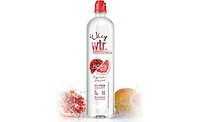Soy Gets Specific
Soy Gets Specific
By SARAH THEODORE
Niche markets create new opportunities for soy products
The soy industry rode the wave of heart health for several years, but according to soy ingredient suppliers, consumers have become aware of soy for a variety of other factors, including weight-loss, satiety, protein enhancement and relief of menopausal symptoms.
The Food and Drug Admin-istration ignited interest
in soy in 1999 when it approved a health claim that said 25 grams of soy
protein per day (or 6.25 grams per serving) as part of a diet low in
saturated fat and cholesterol can help reduce the risk of heart disease.
While that still is an important message for many consumers, soy beverages,
like so many other parts of the beverage industry, are becoming more
segmented for specific consumer targets.
“In general, there is a perception that
consumers want things that are more healthy, so the reason for using soy is
to create products that are better for you,” says Deborah Schulz,
market development manager at Cargill, Minneapolis. “What
you’ll find differentiates people is how they define better for you.
Some people will go to the specifics of soy heart health, others will go to
the more generic halo effect of ‘soy is good for you.’ Some people may not mention soy at all, but go down the protein
route, so there are a lot of different ways of positioning it and to
differentiate it in the marketplace.”
Cargill recently conducted research on consumer
attitudes toward soy as part of its effort to create awareness for its
Prolisse soy protein isolate, which was developed to have a mild flavor.
Prolisse isolates are created using a proprietary physical method to
separate the protein from the rest of the soybean as opposed to more
traditional acid precipitation methods.
“We believe that’s a more natural way of
manufacturing the protein,” Schulz says. “It also provides a
little bit different functional characteristic as far as solubility is
concerned, and the most important is that it’s a better-flavored
product.”
The company created a new logo for Prolisse and is in
the early stages of promoting the ingredient to consumers. The research the
company conducted shows that balanced nutrition and sustained energy are
two of the messages that resonate with consumers in regard to protein. This
likely is a result of the low-carb phenomenon and the emphasis on the
energy peaks and lows emphasized by the glycemic index.
While the low-carb trend has died out, it resulted in
an overall better understanding of protein and its contribution to the
diet, and provided a broader outlook on soy. “Consumers are becoming
increasingly aware of and more knowledgeable of the benefits of protein in
the diet, recognizing the important role it plays in helping manage hunger,
sustain energy levels and maximize performance,” says Jean Heggie,
director of North American marketing at the Solae Co., St. Louis.
“Consumers, too, are beginning to distinguish between sources of
protein, gravitating more and more to ‘lean,’ high-quality
proteins, such as soy.”
No longer competitors
The combination of soy with other types of protein has
long been used in the meat industry, and Kerry Ingredients-Proteins &
Nutritionals, Waukesha, Wis., has developed technology, in the form of
co-processed soy and dairy proteins, to bring that capability to beverages.
“At the moment, this whole blending thing is
right at the beginning in terms of beverage applications,” says Terry
Gieseke, business development director at Kerry Ingredients-Proteins &
Nutritionals. “You have massive case history in the food industry if
you look at meat and soy. Dairy and soy have always competed for the same
space. To put the benefits of both of them together is pretty
significant.”
Because Kerry is involved in both dairy and soy
ingredients, the company has full control over both supply streams.
“All of the quality and security is in place, so if you don’t
want antibiotics and you don’t want growth hormones and you want
grass-fed cattle and all of that, [Kerry can provide that],” Gieseke
says.
For organic products, Kerry offers organic soy
protein, and while its dairy proteins are not organic, they can be organic
compliant. The co-processed proteins provide a clean flavor and heat
stability, and they allow beverage companies to create products with high
protein content that are not as thick as traditional protein shakes, but
closer to the consistency of 2 percent milk. “With this combination,
you can get what I would call almost a refreshing viscosity,” Gieseke
says.
Solae’s Heggie says her company also is seeing
increased use of dairy and soy combinations. “We are doing a lot of
work with blended protein systems for performance nutrition beverages as
well as weight-management beverages,” she says. “Blending soy
and milk proteins, for instance, often delivers better mouthfeel, better
flavor, better economics and unique nutritional positionings vs. all-dairy
or all-soy formulations.
“Nutritionally, milk and soy are quite
complementary,” she adds. “They have complementary amino acid
profiles, which are relevant particularly in performance nutrition. They
also have complementary metabolism rates, which, when blended, have
potential implications for more sustained energy management, hunger
management and muscle-building benefits.”
Soy can be particularly helpful in weight management
because it is naturally low in fat and cholesterol free. Protein aids in a
feeling of satiety and it helps build lean muscle mass and speed muscle
recovery, as well as promoting sustained energy levels.
Other types of products that could benefit from soy
include juice and soy blends, which are seen by many soy providers as a
promising category for future beverages. “We continue to see a
growing number of beverages featuring a combination of soy protein and
fruit juice, and these beverages are generally intended to appeal to the
health-conscious consumer,” says Annette Higgins director of beverage
marketing and strategy at Solae.
Juice and soy both have naturally healthful qualities,
but the combination of the two is not necessarily a natural one, and
requires a bit of finesse to get them to cooperate.
“Generally, juice is pH-challenged,”
Kerry’s Gieseke explains. “Soy works great in neutral
beverages, and is a little more of a challenge in an acidic
beverage.”
The key to preventing the sedimentation that can occur
with these “pH challenged” products, according to soy
suppliers, is to use soy ingredients specifically designed for acidic
formulations, use the proper processing methods, and in some cases, include
a stabilizing ingredient such as pectin.
In addition to juice blends, soy lends itself to
other nutritional beverage concepts as well. “We have developed
several concept products using our soy proteins, and combining them with
other functional ingredients, such as green tea extract, high antioxidant
fruits like pomegranate, prebiotic fibers and probiotics,”
Solae’s Heggie says. “These concepts demonstrate how you can
build upon the nutritional benefits of soy protein
by combining it with other healthful, functional ingredients, enhancing the
health and nutritional appeal of your product.”
Cargill’s Schulz says nutritional shots such as
those on the market in Europe and Japan could be another potential
“what if” concept for soy. And she says we shouldn’t rule
out traditional soymilk products just yet.
“I still see huge potential in milk-like
products,” she says, pointing out that, despite strong growth,
soymilk sales still are relatively low compared with dairy milk sales.
“There are soymilks out there that are made from
isolate and from the traditional bean, but one of the advantages that the
isolate gives you is flexibility in your formulation,” she says.
“When you come from the whole bean, you have your nutritional profile
and that’s pretty much it; it’s
more of a challenge to vary the protein content. Having the flexibility of
an isolate can also provide opportunities in how to formulate a
product.”
Easing the change
Soy’s ability to
ease menopausal symptoms has been touted by naturalists for some time, and
Archer Daniels Midland, Decatur, Ill., is using that capability to market
its NovaSoy soy isoflavones. The ingredient, it says, closely matches the
soybean’s natural isoflavone ratio of 50 percent genistein, 40
percent daidzein and up to 10 percent glycitein.
“We have recently been working with several
beverage companies to include NovaSoy soy isoflavones in their new healthy
formulations for adults,” says Liza Pepple, product manager for
NovaSoy. “By including soy isoflavone extract, companies can ensure a
consistent dose of isoflavones in an amount that has been clinically proven
as beneficial for relief of certain symptoms such as hot
flashes.”
ADM has begun a campaign to educate “health
influencers” and consumers about soy isoflavones. Pepple says Menopause, the Journal of the
North American Menopause Society, recently reviewed isoflavone supplements
and how well they relieve hot flashes, and concluded that supplements
containing at least 15 mg. of genistein were more consistently effective in
reducing symptoms.
In addition to NovaSoy, ADM produces CardioAid plant
sterols, which are plant-derived compounds intended to help block the
absorption of cholesterol. CardioAid is GRAS-approved for a range of
categories, including beverages and dairy products. And it says its
NutriSoy organic whole bean powder allows almost any dairy operation to
produce its own soymilk using existing dairy milk processing equipment and
packaging. The ingredient incorporates the entire bean, so ADM says the
natural nutrition of the whole soybean is maintained.
Helpful hints
When formulating a soy beverage, it is important to
remember that one protein does not fit all, says Solae’s Higgins.
“Soy proteins are highly specialized and application specific,”
she says.
Key considerations for a ready-to-drink neutral
beverage, for example, include flavor performance, solubility, viscosity,
dispersibility, mouthfeel and nutrition. As mentioned earlier, the pH
differences in juice and soy blends require the use of a stabilization
system and proper processing. Solae, she says offers a range of proteins,
from those recommended for high-protein beverages (more than 4 percent
protein) to those for lower protein products.
“Proteins that exhibit good solubility produce
beverages with better mouthfeel and suspension stability,” Higgens
says. “Proteins with higher viscosity produce thicker beverages.
Those with good dispersibility support optimal processing.
“Creating and launching a successful protein
beverage requires more than simply selecting the right protein — one
must also refine the product’s processing, total formulation and
market positioning. It is important to define the consumer target audience
and to understand their needs and motivations.”
BI
High hopes for hemp
Soymilk is the main competitor to dairy milk in the
United States, but a Washington, D.C.-based group called Vote Hemp is
lobbying to allow U.S. farmers to grow hemp for food products under state
or federal regulation. According to the organization, hempmilk is high in
protein like soymilk, but hemp does not contain phytic acid and trypsin
inhibitors. It says hempmilk is a good source of balanced omega-3 and
omega-6 fatty acids and contains a range of naturally occurring vitamins
and minerals, such as vitamin E, folic acid, iron, niacin, magnesium,
phosphorus, potassium, thiamin and zinc.
Industrial hemp is said to contain very low levels of
the THC cannabinoids present in marijuana, with virtually no psychoactive
effect. Hemp farming is permitted in Canada, and Vote Hemp says products
derived from hemp seed such as Living Harvest Hempmilk and Manitoba Harvest
Hemp Bliss are set to hit the Canadian market in early 2007. Both will be
available in Original, Vanilla and Chocolate flavors.
Looking for a reprint of this article?
From high-res PDFs to custom plaques, order your copy today!





